Design of Active Suspension Controller for Ride Comfort Enhancement and Motion Sickness Mitigation
Abstract
1. Introduction
- Three types of controller structures for SOF control are presented. As an available output for SOF control, the heave velocity, pitch rate and front/rear suspension velocity were selected.
- To find the optimum gain elements of the SOF controllers for nonlinear vehicle models, SBOM was adopted. A Simulink model for a nonlinear vehicle was built and used for SBOM.
- A Simulation was conducted on vehicle simulation software, CarSim. From the comparison results, the best SOF control structure for ride comfort enhancement and motion sickness mitigation was identified.
2. Controller Design with Simulation-Based Optimization
2.1. Half-Car Model for Controller Design
2.2. Design of Linear Quadratic Regulator
2.3. Design of Linear Quadratic Static Output Feedback Controller
2.4. Design of Static Output Feedback Controller with Simulation-Based Optimization
3. Simulation
3.1. Simulation Environment
3.2. Comparison of Controllers on CarSim
4. Conclusions
Author Contributions
Funding
Data Availability Statement
Conflicts of Interest
Nomenclature
| DSOF | derivative static output feedback control |
| LQOC | linear quadratic optimal control |
| LQR | linear quadratic regulator |
| LQSOF | linear quadratic static output feedback |
| LQSSOF | linear quadratic structured static output feedback |
| LQDSOF | linear quadratic derivative static output feedback |
| SBOM | simulation-based optimization method |
| SOF | static output feedback |
| SSOF | structured static output feedback |
| SSB | single sine bump |
| SWR | sine wave road |
| Iy | pitch moment of inertial (kg⋅m2) |
| bsf, bsr | damping coefficient of dampers at front and rear suspensions (N⋅s/m) |
| ksf, ksr | spring stiffness of springs at front and rear suspensions (N/m) |
| ktf, ktr | spring stiffness of front and rear tires (N/m) |
| lf, lr | distances from center of gravity of a sprung mass to front and rear axles (m) |
| ms | sprung mass (kg) |
| muf, mur | unsprung masses (kg) |
| uf, ur | forces generated by front and rear active suspensions (N) |
| zc | heave displacement at center of gravity of a sprung mass (m) |
| zrf, zrr | road elevations of front and rear tire-road contact positions (m) |
| zsf, zsr | vertical displacements of front and rear corners of a sprung mass (m) |
| zuf, zur | vertical displacements of front and rear wheel centers (m) |
| ξi | maximum allowable value of weight in LQ objective function |
| ρi | weight in LQ objective function |
| θ | pitch angle of a sprung mass (rad) |
References
- Tseng, H.E.; Hrovat, D. State of the art survey: Active and semi-active suspension control. Veh. Syst. Dyn. 2015, 53, 1034–1062. [Google Scholar] [CrossRef]
- ISO 2631-1; Mechanical Vibration and Shock—Evaluation of Human Exposure to Whole-Body Vibration—Part 1: General Requirements. International Organization for Standardization: Geneva, Switzerland, 1997.
- Rimell, A.N.; Mansfield, N.J. Design of digital filters for frequency weightings required for risk assessments of workers exposed to vibration. Ind. Health 2007, 45, 512–519. [Google Scholar] [CrossRef] [PubMed]
- Yurtsever, E.; Lambert, J.; Carballo, A.; Takeda, K. A survey of autonomous driving: Common practices and emerging tech-nologies. IEEE Access 2020, 8, 58443–58469. [Google Scholar] [CrossRef]
- Diels, C.; Bos, J.E. Self-driving carsickness. Appl. Ergon. 2016, 53, 374–382. [Google Scholar] [CrossRef] [PubMed]
- Cheung, B.; Nakashima, A. A Review on the Effects of Frequency of Oscillation on Motion Sickness; Technical Report, TR 2006-229; Defence R&D Canada: Toronto, ON, Canada, 2006. [Google Scholar]
- McCauley, M.E.; Royal, J.W.; Wylie, C.D.; O’Hanlon, J.F.; Mackie, R.R. Motion Sickness Incidence: Exploratory Studies of Habituation, Pitch and Roll and the Refinement of a Mathematical Model; Technical Report 1733-2; Human Factors Research Inc.: Goleta, CA, USA, 1976. [Google Scholar]
- Ekchian, J.; Graves, W.; Anderson, Z.; Giovanardi, M.; Godwin, O.; Kaplan, J.; Ventura, J.; Lackner, J.R.; DiZio, P. A High-Bandwidth Active Suspension for Motion Sickness Mitigation in Autonomous Vehicles; SAE Technical Paper 2016-01-1555; SAE International: Warrendale, PA, USA, 2016. [Google Scholar]
- DiZio, P.; Ekchian, J.; Kaplan, J.; Ventura, J.; Graves, W.; Giovanardi, M.; Anderson, Z.; Lackner, J.R. An active suspension system for mitigating motion sickness and enabling reading in a car. Aerosp. Med. Hum. Perform. 2018, 89, 822–829. [Google Scholar] [CrossRef]
- Jurisch, M.; Holzapfel, C.; Buck, C. The influence of active suspension systems on motion sickness of vehicle occupants. In Proceedings of the IEEE 23rd International Conference on Intelligent Transportation Systems (ITSC), Rhodes, Greece, 20–23 September 2020. [Google Scholar]
- Hrovat, D. Survey of advanced suspension developments and related optimal control applications. Automatica 1997, 33, 1781–1817. [Google Scholar] [CrossRef]
- Cao, D.; Song, X.; Ahmadian, M. Editors’ perspectives: Road vehicle suspension design, dynamics, and control. Veh. Syst. Dyn. 2011, 49, 3–28. [Google Scholar] [CrossRef]
- Al-Ashmori, M.; Wang, X.A. Systematic literature review of various control techniques for active seat suspension systems. Appl. Sci. 2020, 10, 1148. [Google Scholar] [CrossRef]
- Park, M.; Yim, S. Design of static output feedback and structured controllers for active suspension with quarter-car model. Energies 2021, 14, 8231. [Google Scholar] [CrossRef]
- Jeong, Y.; Shon, Y.; Chang, S.; Yim, S. Design of static output feedback controllers for an active suspension system. IEEE Access 2022, 10, 26948–26964. [Google Scholar] [CrossRef]
- Yim, S.; Choi, J.; Yi, K. Coordinated control of hybrid 4WD vehicles for enhanced maneuverability and lateral stability. IEEE Trans. Veh. Technol. 2012, 61, 1946–1950. [Google Scholar] [CrossRef]
- Nah, J.; Yim, S. Optimization of control allocation with ESC, AFS, ARS and TVD in integrated chassis control. J. Mech. Sci. Technol. 2019, 33, 2941–2948. [Google Scholar] [CrossRef]
- Jeong, Y.; Shon, Y.; Chang, S.; Yim, S. Design of virtual reference feedforward controller for an active suspension system. IEEE Access. 2022, 10, 65671–65684. [Google Scholar] [CrossRef]
- Hansen, N.; Muller, S.D.; Koumoutsakos, P. Reducing the time complexity of the derandomized evolution strategy with covariance matrix adaptation (CMA-ES). Evol. Comput. 2003, 11, 1–18. [Google Scholar] [CrossRef] [PubMed]
- Lu, J.; DePoyster, M. Multiobjective optimal suspension control to achieve integrated ride and handling performance. IEEE Trans. Control Syst. Technol. 2002, 10, 807–821. [Google Scholar]
- Jung, Y.H.; Choi, J.W.; Seo, Y.B. Overlapping decentralized EA control design for an active suspension system of a full car model. In Proceedings of the 39th SICE Annual Conference, Iizuka, Japan, 28 July 2000; pp. 85–90. [Google Scholar]
- Bryson, A.E.; Ho, Y.C. Applied Optimal Control; Hemisphere: New York, NY, USA, 1975. [Google Scholar]
- Ding, R.; Wang, R.; Meng, X.; Chen, L. Energy consumption sensitivity analysis and energy-reduction control of hybrid electromagnetic active suspension. Mech. Syst. Signal Process. 2019, 134, 106301. [Google Scholar] [CrossRef]
- Liu, W.; Wang, R.; Ding, R.; Meng, X.; Yang, L. On-line estimation of road profile in semi-active suspension based on unsprung mass acceleration. Mech. Syst. Signal Process. 2020, 135, 106370. [Google Scholar] [CrossRef]
- Mechanical Simulation Corporation. CarSim Data Manual; Version 8; Mechanical Simulation Corporation: Ann Arbor, MA, USA, 2009. [Google Scholar]
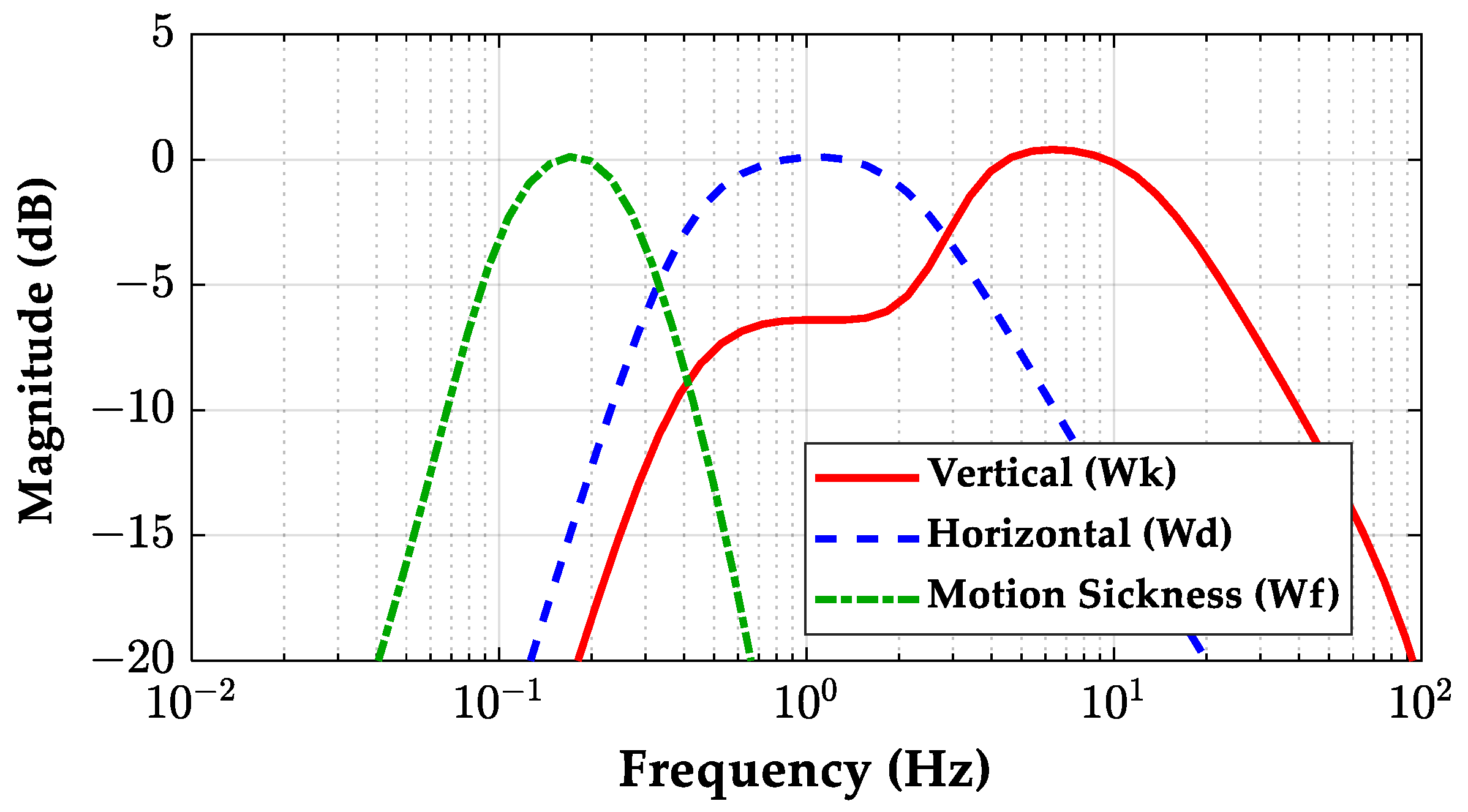

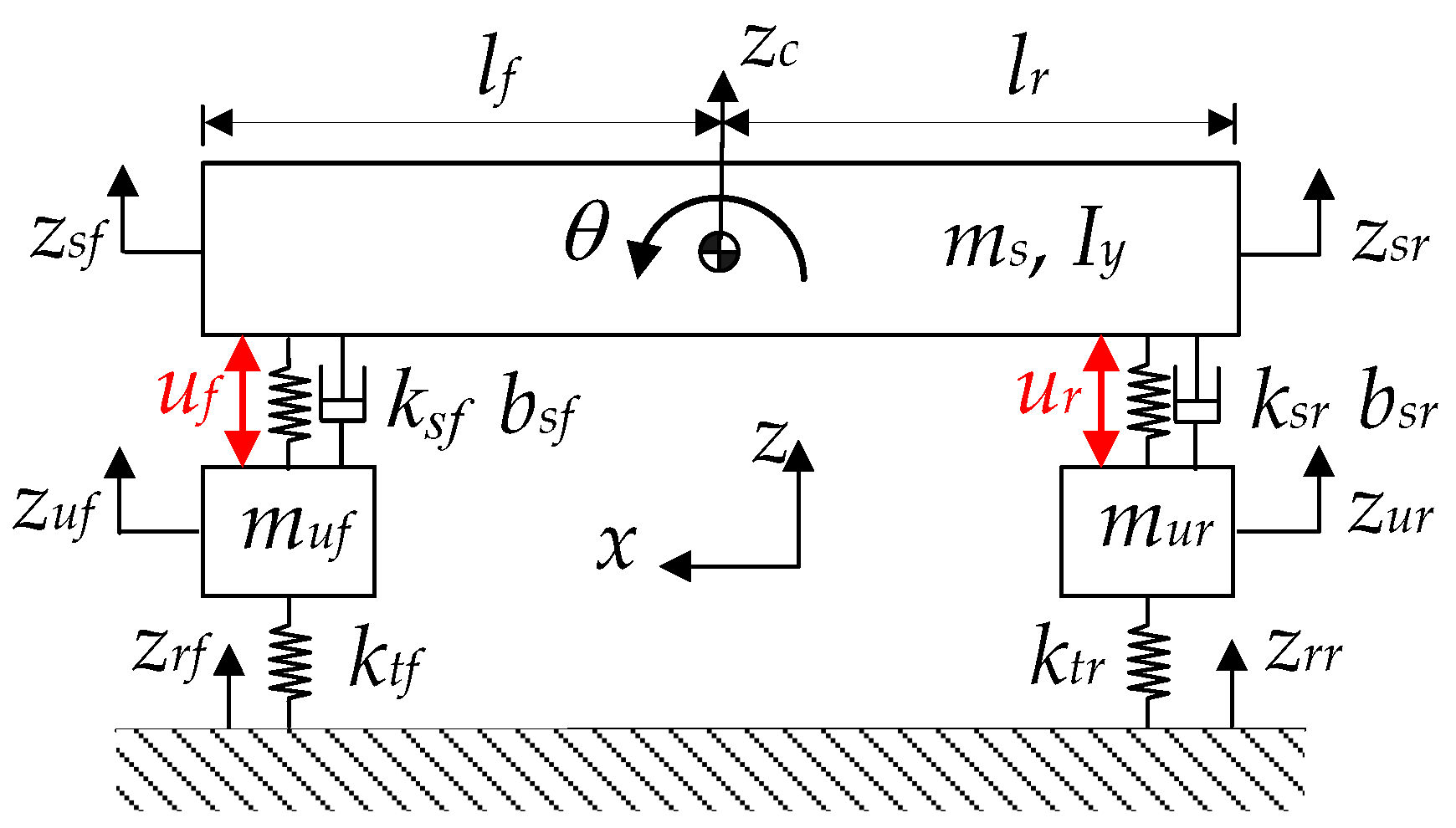



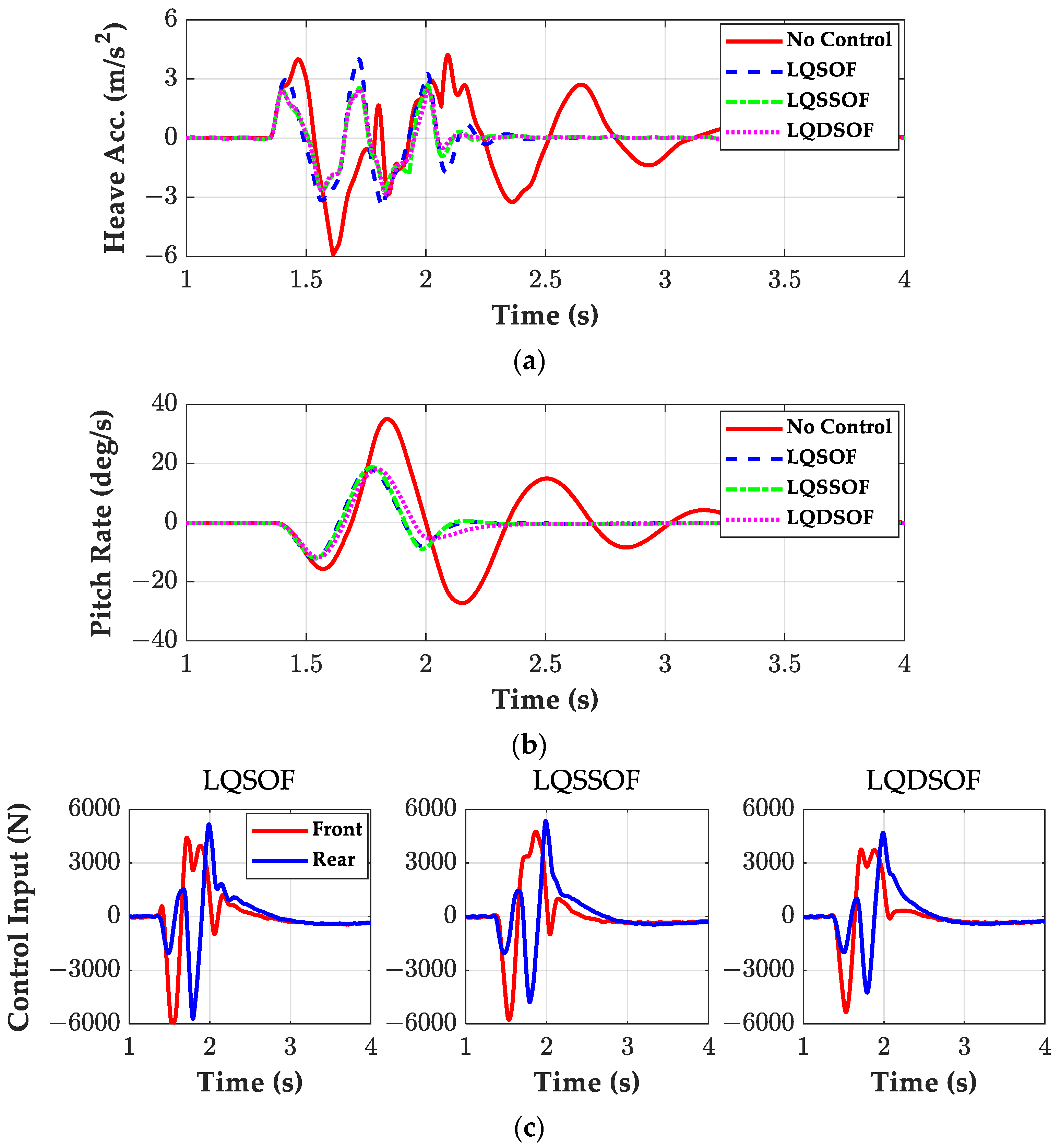
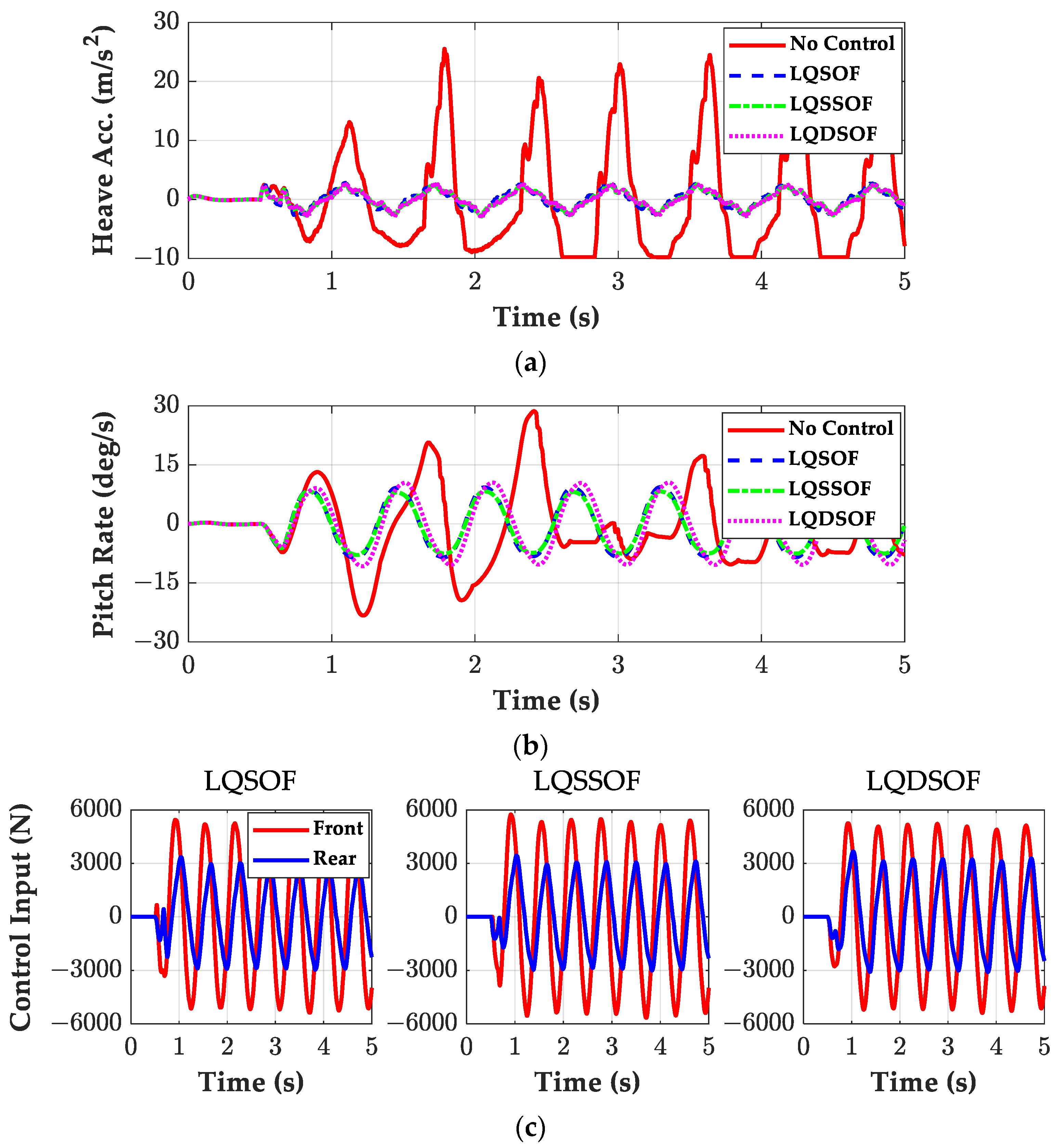
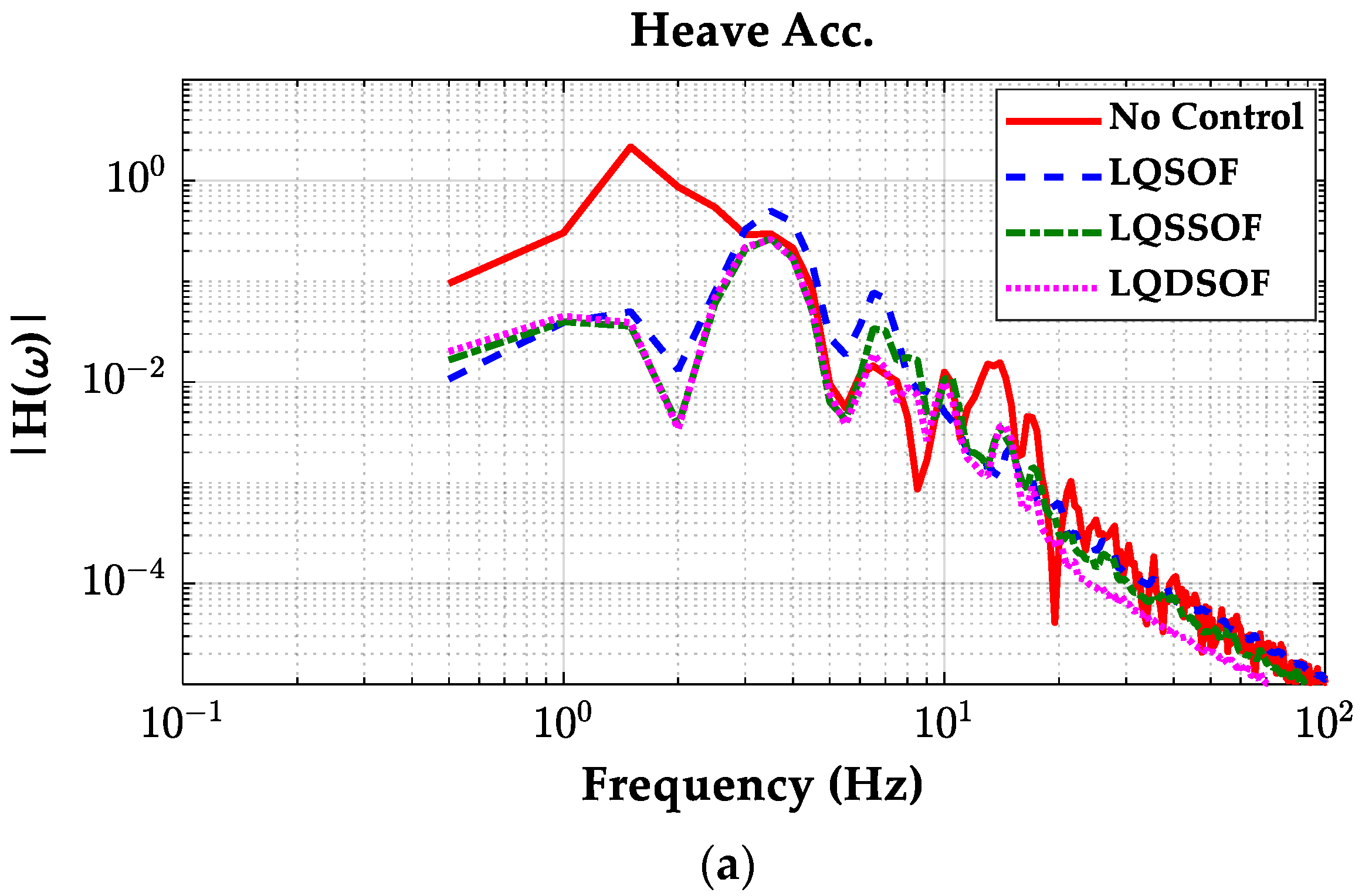

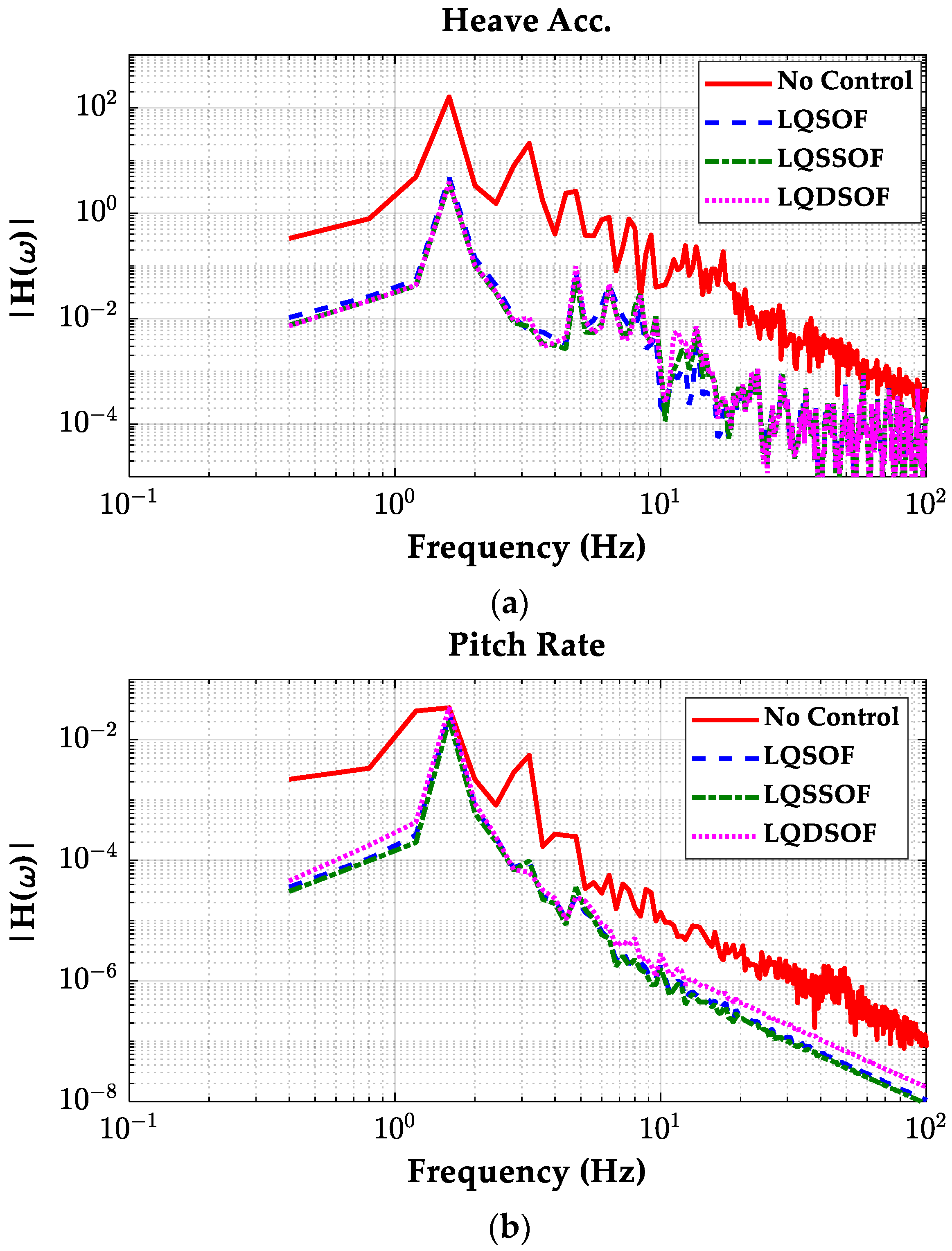
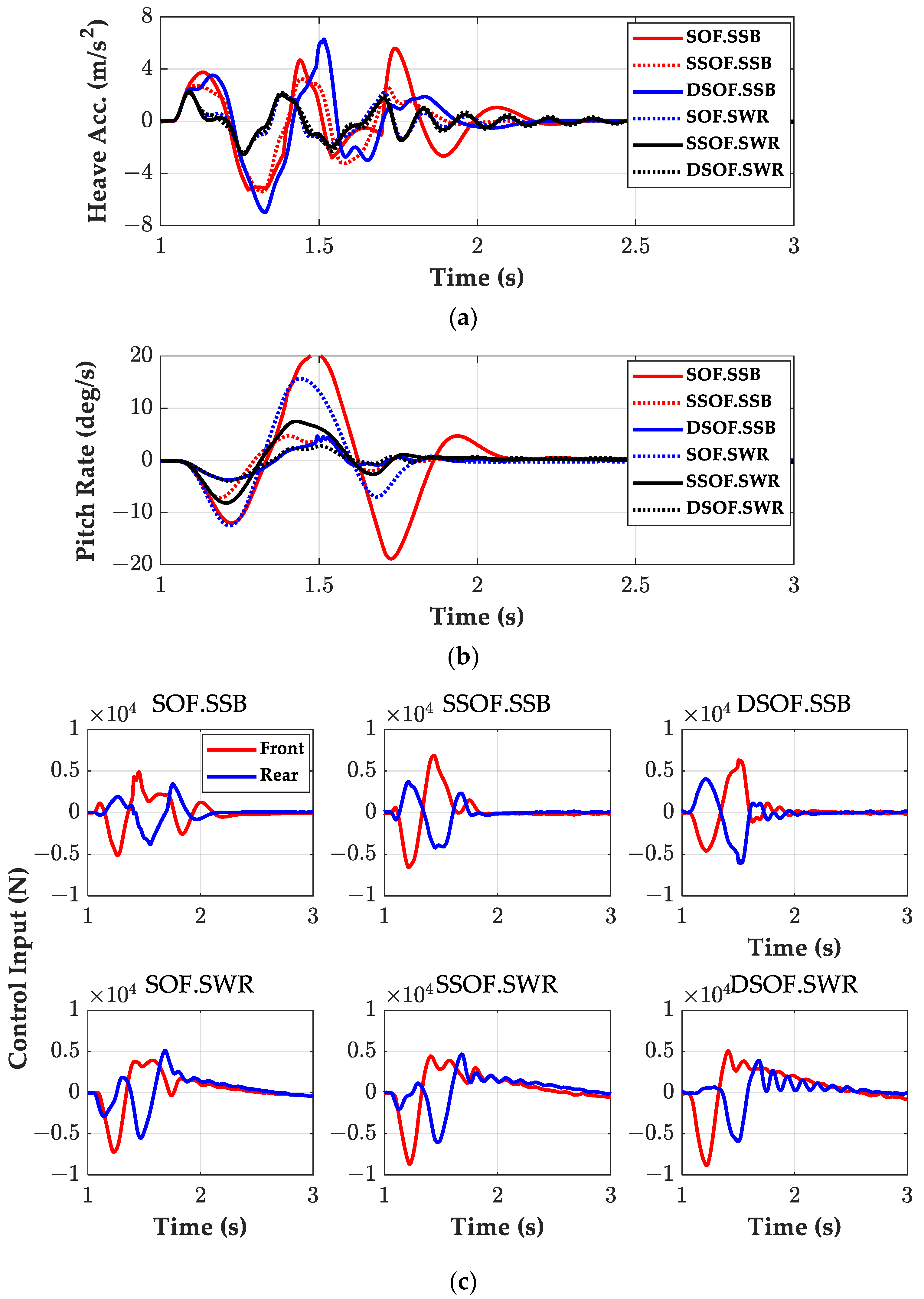
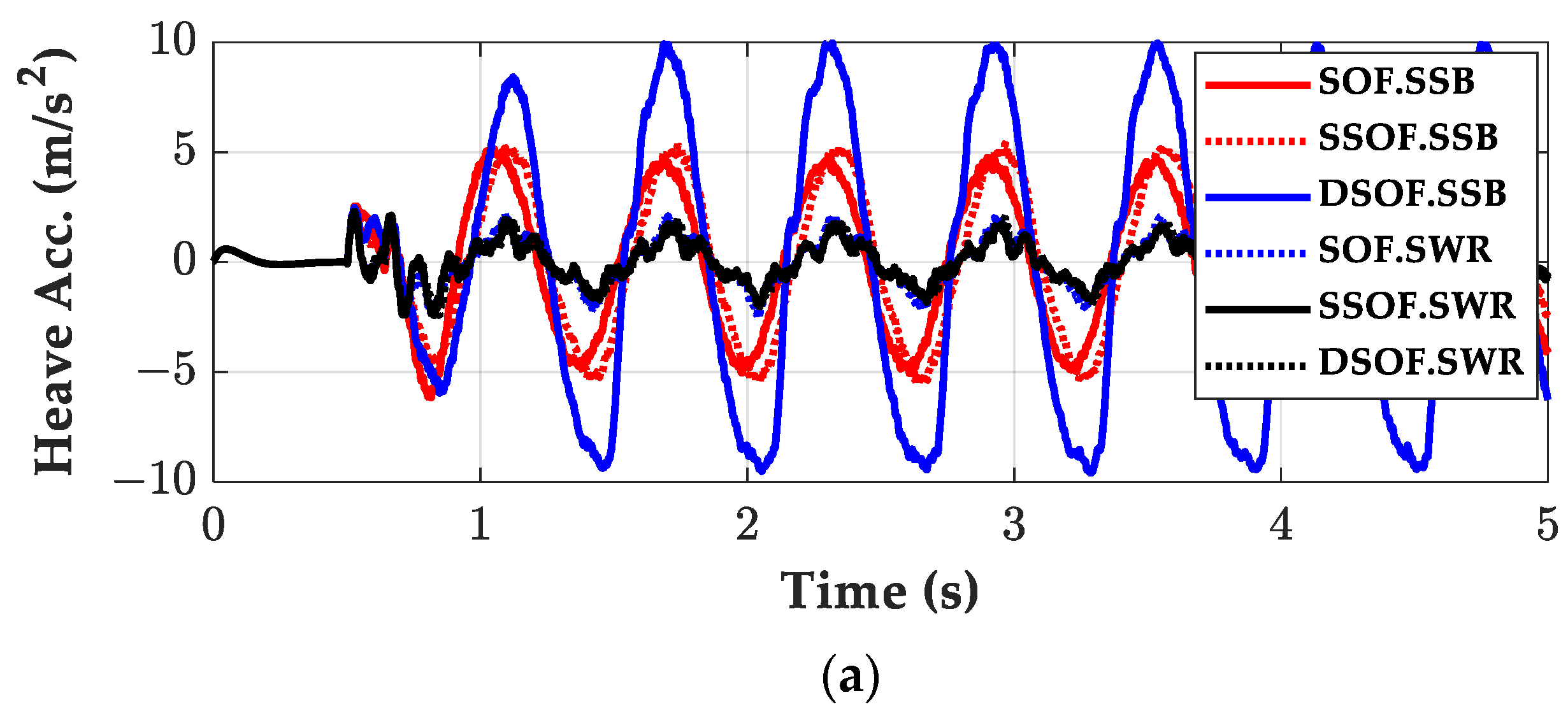
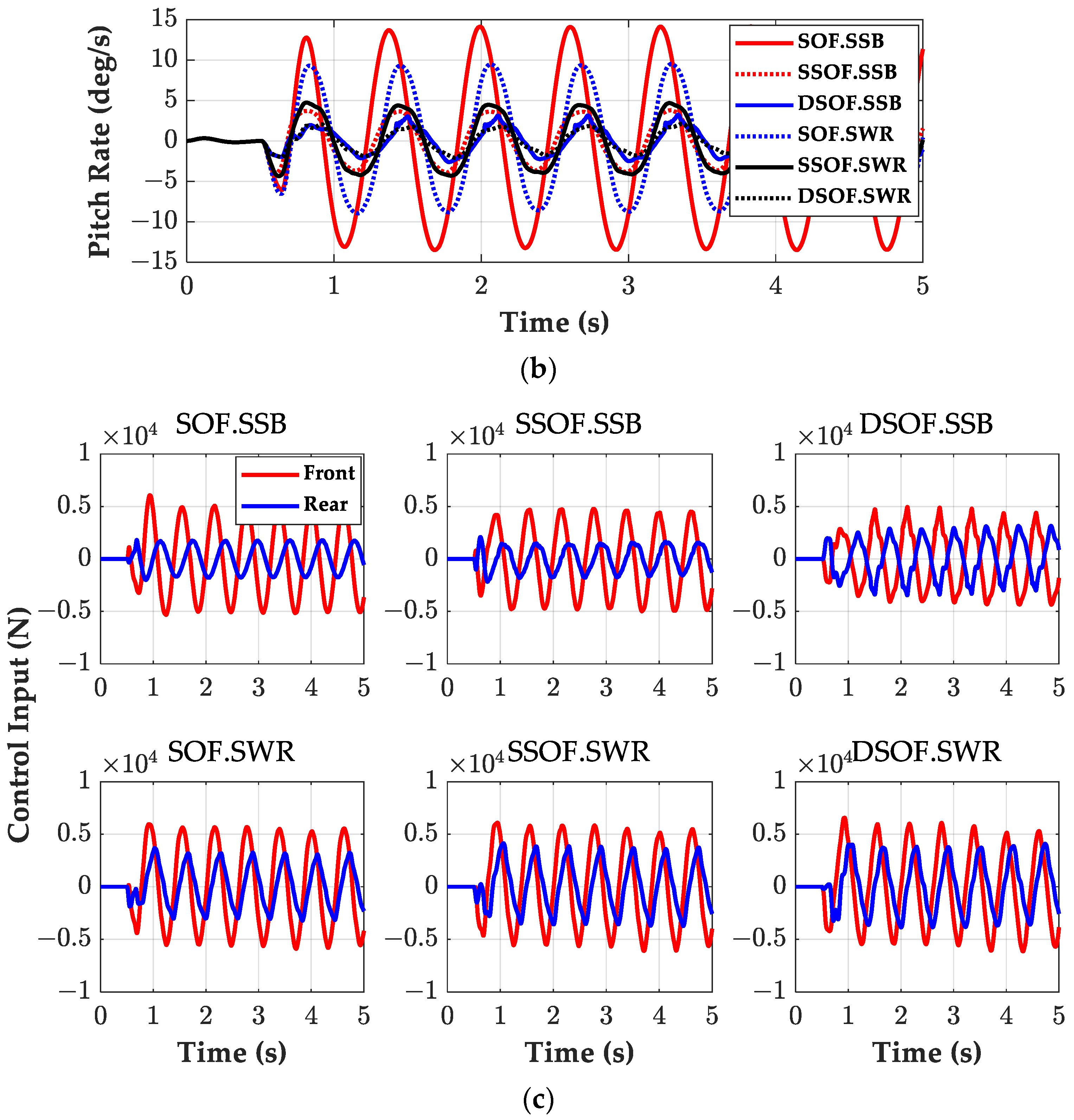
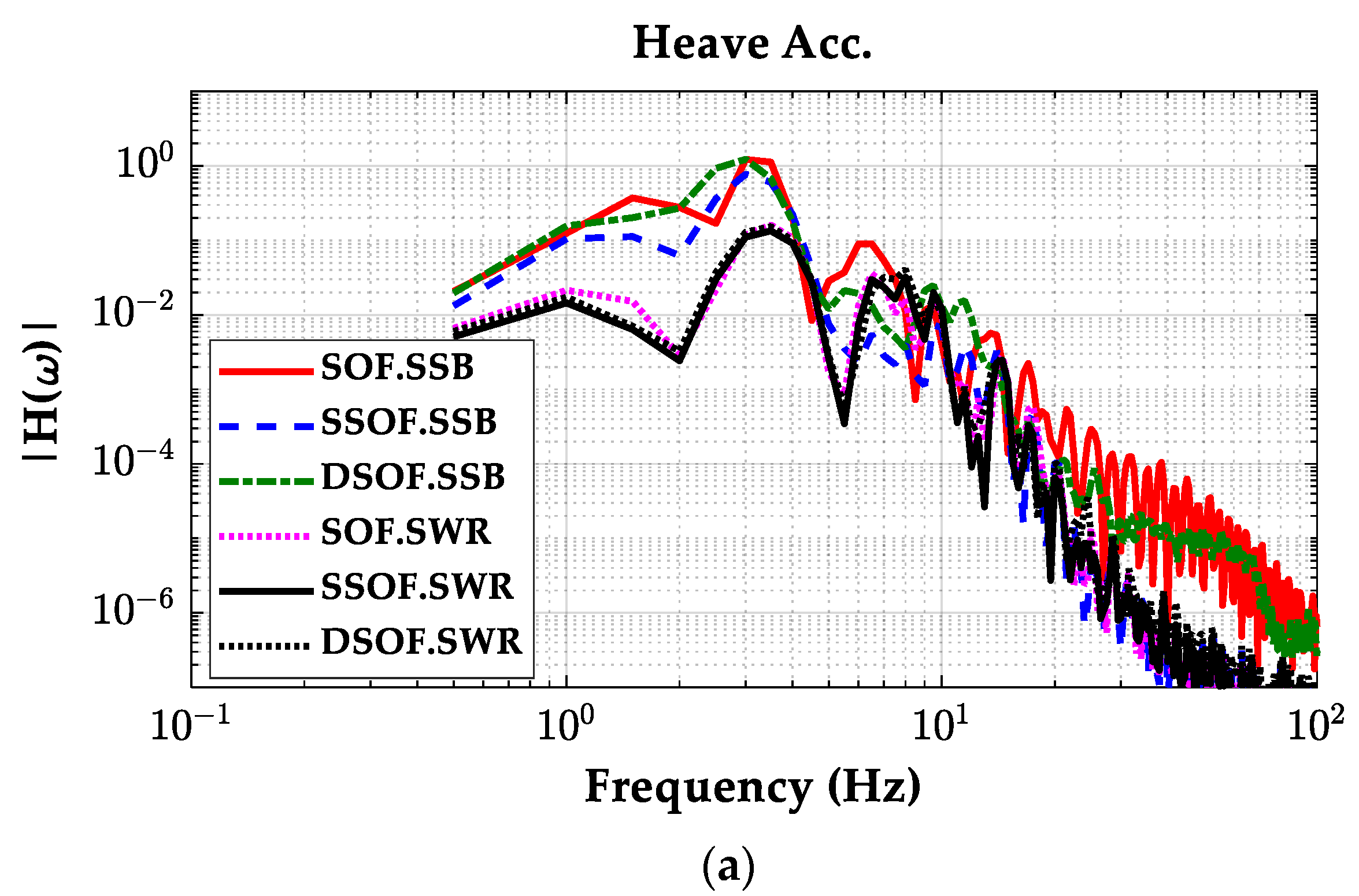
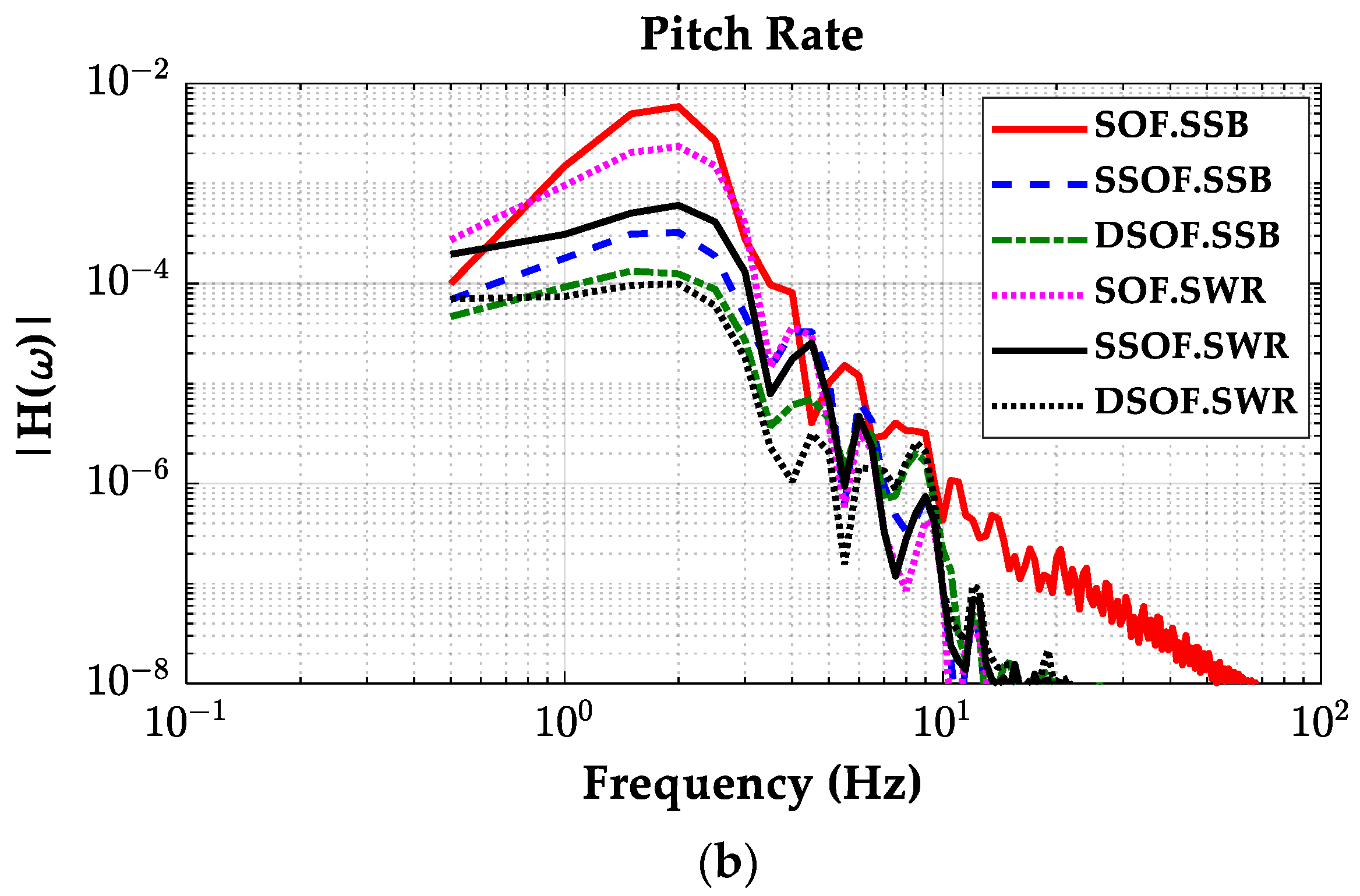
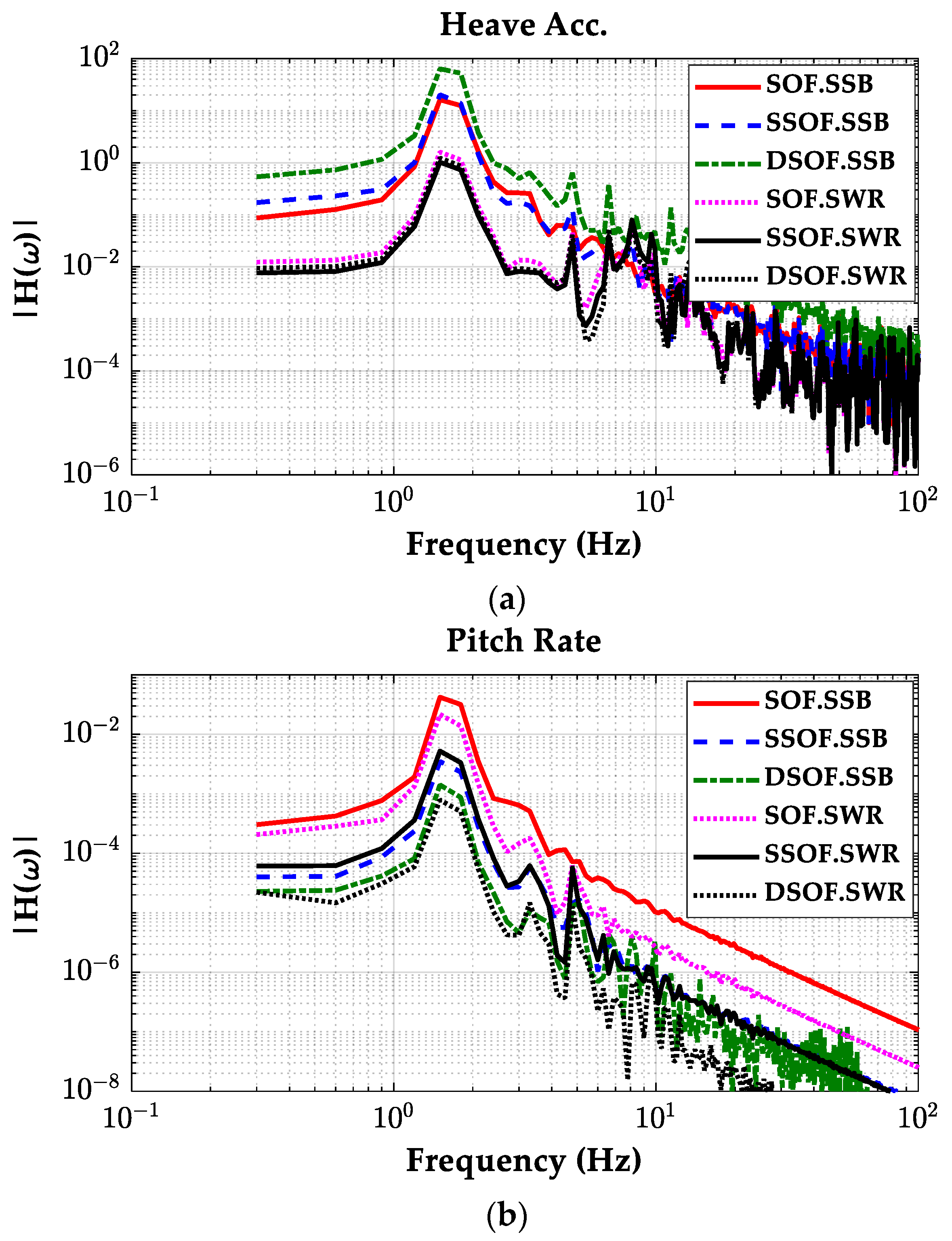
| Parameter | Value | Parameter | Value |
|---|---|---|---|
| ms | 1653 kg | mu | 22.5 kg |
| Iy | 2765 kg⋅m2 | ktf, ktr | 230,000 N/m |
| lf | 0.8 m | lr | 1.646 m |
| ksf, ksr | 34,000 N/m | bsf, bsr | 3500 Ns/m |
| Weight | Variable | Value | Weight | Variable | Value |
|---|---|---|---|---|---|
| ξ1 | Heave acc. | 0.1 m/s2 | ξ2 | Pitch angular acc. | 30 deg/s2 |
| ξ3 | Pitch rate | 2 deg/s | ξ4 | Pitch angle | 2 deg |
| ξ5 | Suspension stroke | 0.03 m | ξ6 | Tire deflection | 0.03 m |
| ξ7 | Control input | 5000 N |
| Road Profile | Controller | (m/s2) | (deg/s) | Max Front Force (N) | Max Rear Force (N) |
|---|---|---|---|---|---|
| Single sine bump | No Control | 5.9 | 35.0 | ||
| LQSOF | 4.0 | 18.0 | 6045 | 5720 | |
| LQSSOF | 2.7 | 18.7 | 5777 | 5347 | |
| LQDSOF | 2.9 | 18.1 | 5342 | 4679 | |
| Sine wave road | No Control | 25.5 | 28.6 | ||
| LQSOF | 3.1 | 9.3 | 5448 | 3343 | |
| LQSSOF | 2.9 | 8.3 | 5745 | 3432 | |
| LQDSOF | 3.0 | 10.8 | 5393 | 3664 |
| Road Profile | Controller | (m/s2) | (deg/s) | Max Front Force (N) | Max Rear Force (N) |
|---|---|---|---|---|---|
| Single sine bump | No Control | 5.9 | 35.0 | ||
| SOF.SSB | 5.6 | 20.4 | 5139 | 3800 | |
| SSOF.SSB | 5.4 | 7.1 | 6882 | 4206 | |
| DSOF.SSB | 7.0 | 4.7 | 6319 | 6083 | |
| SOF.SWR | 2.5 | 15.7 | 7224 | 5499 | |
| SSOF.SWR | 2.5 | 8.2 | 8670 | 6042 | |
| DSOF.SWR | 2.4 | 3.9 | 8849 | 5904 | |
| Sine wave road | No Control | 25.5 | 28.6 | ||
| SOF.SSB | 6.2 | 14.2 | 6065 | 2000 | |
| SSOF.SSB | 5.5 | 4.1 | 4991 | 2173 | |
| DSOF.SSB | 10.2 | 3.2 | 4943 | 3465 | |
| SOF.SWR | 2.4 | 9.5 | 5960 | 3685 | |
| SSOF.SWR | 2.4 | 4.7 | 6103 | 4139 | |
| DSOF.SWR | 2.4 | 2.1 | 6574 | 4090 |
Disclaimer/Publisher’s Note: The statements, opinions and data contained in all publications are solely those of the individual author(s) and contributor(s) and not of MDPI and/or the editor(s). MDPI and/or the editor(s) disclaim responsibility for any injury to people or property resulting from any ideas, methods, instructions or products referred to in the content. |
© 2024 by the authors. Licensee MDPI, Basel, Switzerland. This article is an open access article distributed under the terms and conditions of the Creative Commons Attribution (CC BY) license (https://creativecommons.org/licenses/by/4.0/).
Share and Cite
Jeong, Y.; Yim, S. Design of Active Suspension Controller for Ride Comfort Enhancement and Motion Sickness Mitigation. Machines 2024, 12, 254. https://doi.org/10.3390/machines12040254
Jeong Y, Yim S. Design of Active Suspension Controller for Ride Comfort Enhancement and Motion Sickness Mitigation. Machines. 2024; 12(4):254. https://doi.org/10.3390/machines12040254
Chicago/Turabian StyleJeong, Yonghwan, and Seongjin Yim. 2024. "Design of Active Suspension Controller for Ride Comfort Enhancement and Motion Sickness Mitigation" Machines 12, no. 4: 254. https://doi.org/10.3390/machines12040254
APA StyleJeong, Y., & Yim, S. (2024). Design of Active Suspension Controller for Ride Comfort Enhancement and Motion Sickness Mitigation. Machines, 12(4), 254. https://doi.org/10.3390/machines12040254







